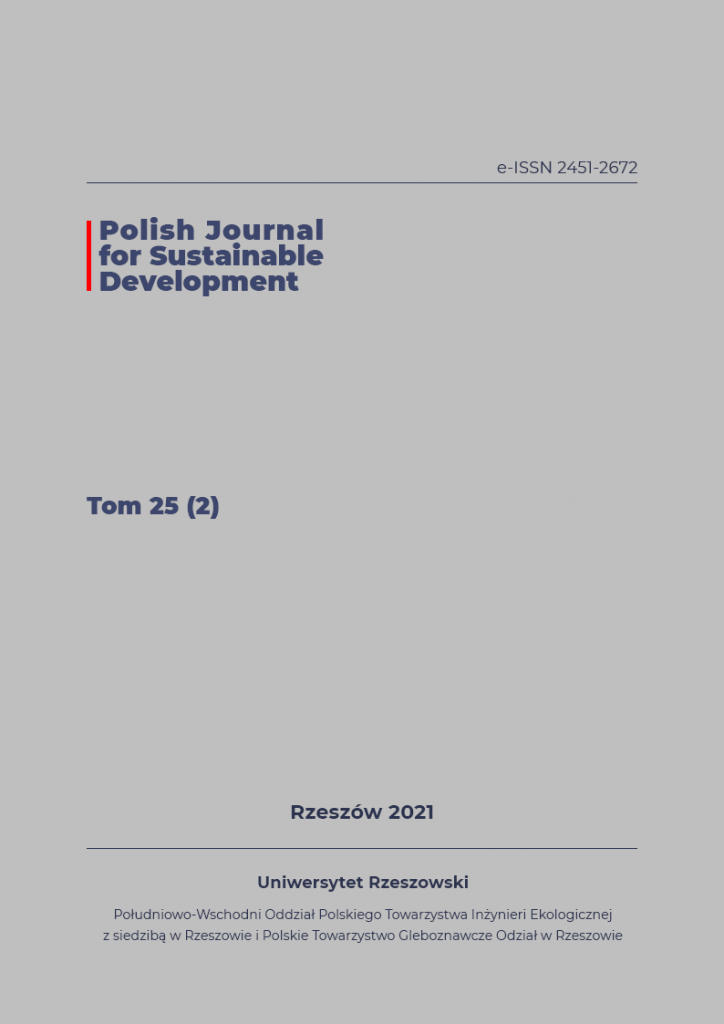Struktura zespołów dżdżownic w uprawie kukurydzy i pszenicy
DOI:
https://doi.org/10.15584/pjsd.2021.25.2.3Słowa kluczowe:
Lumbricidae, zboża, bioróżnorodność, Podkarpacie, badania terenoweAbstrakt
Dżdżownice odgrywają ważną rolę w glebie. Podczas kopania korytarzy rozluźniają, napowietrzają ją i mieszają minerały z częścią organiczną. Przyczyniają się znacząco do poprawy jej żyzności. Organizmy te są także powszechnie stosowane w monitorowaniu stanu gleb o różnym stopniu antropopresji. Celem badań była analiza struktury zbiorowisk dżdżownic. Badania przeprowadzono na dwóch stanowiskach (w uprawie kukurydzy i pszenicy). Lumbricidae zbierano metodą mieszaną, tj. analizowano bloki gleby o wymiarach 25 x 25 x 25 cm. Sortowano je ręcznie w celu ekstrakcji dżdżownic. Do wypłukania skąposzczetów z głębszych warstw gleby użyto 10 litrów 0,4% roztworu formaliny. Gleba pod uprawą pszenicy charakteryzowała się wyższym zagęszczeniem Lumbricidae. Znaleziono tu cztery gatunki dżdżownic. Największy udział w zbiorowisku dżdżownic na obu stanowiskach miała A. rosea. Badania należy kontynuować przez dłuższy czas.
Downloads
Bibliografia
Bach E. M., Ramirez K. S., Fraser T. D., Wall D. H. 2020. Soil Biodiversity Integrates Solutions for a Sustainable Future. Multidisciplinary Digital Publishing Institute. 12(2662). 1-20.
Donohoe M. 2003. Causes and health consequences of environmental degradation and social injustice. Social Science & Medicine. 56. 573-587.
Feledyn-Szewczyk B., Stalenga J. 2016. Biodiversity as an ecosystem service and methods of its evaluation. Intercathedra. 32. 14-24.
International Standards Organization (ISO). 2006. ISO 23611-1:2006. Soil Quality-Sampling of Soil Invertebrates-Part 1: Hand-Sorting and Formalin Extraction of Earthworms. Geneva. Switzerland.
Kasprzak K. 1986. Skąposzczety glebowe, III. Rodzina: Dżdżownice (Lumbricidae). Klucze do oznaczania bezkręgowców Polski. Państwowe Wydawnictwo Naukowe. Warszawa. 9-80.
Kostecka J., Podolak A., Mazur-Pączka A. 2017. Postrzeganie wartości przestrzeni - skutki dla retardacji tempa zawłaszczania ekosystemów przez człowieka. Biuletyn Polska Akademia Nauk. Komitet Przestrzennego Zagospodarowania Kraju. 267. 70-88.
Niklińska M. 2010. Wpływ zanieczyszczeń na funkcje gleby w środowisku i w życiu człowieka. Wszechświat. 111(1-3). 44-50.
Paoletti M. G. 1999. The role of earthworms for assessment of sustainability and as bioindicators. Agriculture, Ecosystems and Environment. Elsevier. 74. 137-155.
Regulska E. 2019. Potencjał krajobrazów rolniczych do świadczenia usługi dekompozycji materii organicznej. Przegląd Geograficzny. 91(1). 107-119.
Trojan P. 1975. Ekologia ogólna. PWN. Warszawa. 419.
Pobrania
Opublikowane
Numer
Dział
Licencja
Prawa autorskie (c) 2021 Polish Journal for Sustainable Development

Utwór dostępny jest na licencji Creative Commons Uznanie autorstwa – Użycie niekomercyjne – Bez utworów zależnych 4.0 Międzynarodowe.


